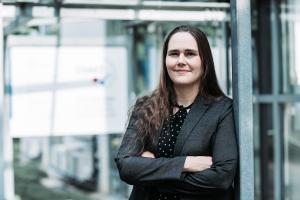(MENAFN- EIN Presswire)

Meina Neumann-Schaal, PhD

Symbolic picture, industry; source: pixabay/Foto-Rabe
New pathways found for biotechnological degradation of industrial waste
This is only the beginning of research in this area.” — Meina Neumann-Schaal, PhD
BRAUNSCHWEIG, LOWER SAXONY, GERMANY, August 6, 2021 /EINPresswire.com / -- Scientists led by Dr Meina Neumann-Schaal of the Leibniz Institute DSMZ-German Collection of Microorganisms and Cell Cultures GmbH in Braunschweig, Germany, have characterised the breakdown of phenol by Saccharolobus solfataricus. Using methods from the fields of metabolomics and transcriptomics, the researchers demonstrated that the microorganism is capable of using phenol as sole carbon source for its growth. The group was also the first to identify the complete degradation pathway of this toxic compound. Their findings were recently published in the internationally renowned journal 'Frontiers in Microbiology' (doi: 10.3389/fmicb.2020.587032 ).
Phenol degradation by Saccharolobus solfataricus
S. solfataricus is classified as archaea, a group of microorganisms that together with the better known group of bacteria constitute the so-called prokaryotes. Saccharolobus solfataricus prefers extreme environmental conditions with temperatures of 80°C and acidic surroundings with a pH of 3.5. The researchers' experiments showed that S. solfataricus is able to survive on phenol as sole carbon source. To this end, the microorganism breaks down the toxic organic compound and uses the now available carbon to build up biomass. Until now, the metabolic pathway to achieve this purpose had not been described in detail. Based on their findings, Dr Neumann-Schaal and her team could not only determine the sought-after metabolic pathway, but were also able to postulate enzymes involved in the various reaction steps necessary for the degradation of phenol.
Toxic agent phenol
The organic compound phenol is a chemical agent that commonly occurs as waste product in various industries, for instance the textile industry or fuel production from fossil raw materials such as carbon. Phenol is a pollutant that causes massive damage in humans and animals. In nature, phenol is for example released in low quantities in the degradation of plant material and animals. It is already known that various bacteria and yeasts are able to break down phenol. These microorganisms occur in mesophilic environments, that is to say they live in temperatures between 20 and 45°C. However, since industrial phenol waste commonly develops under high temperatures and low pH-values, it requires a cost- and energy-intensive treatment in the sense of a cool-down and/or neutralisation process to allow the microbial degradation of phenol to begin. In addition, most phenol-degrading bacteria belong to the Pseudomonas family and are often pathogenic, i.e. harmful, to humans and the environment. And this is where the great potential of archaea comes in, explains biochemist Dr Meina Neumann-Schaal.“Using archaea such as Saccharolobus solfataricus could circumvent the problems of re-processing industrial phenol-waste and therefore save costs. We now know which enzymes and proteins are involved in phenol degradation and can therefore specifically look for these in other archaea. There might be other groups that can break down phenol even more efficiently. This is only the beginning of research in this area.”
Original publication
Wolf J., Koblitz J., Albersmeier A., Kalinowski, J. Siebers B., Schomburg D., Neumann-Schaal M. (2021) Utilization of phenol as carbon source by the thermoacidophilic archaeon Saccharolobus solfataricus P2 is limited by oxygen supply and the cellular stress response. Front. Microbiol. 11:587032. doi: 10.3389/fmicb.2020.587032
About the Leibniz Institute DSMZ
The Leibniz Institute DSMZ-German Collection of Microorganisms and Cell Cultures is the world's most diverse collection of biological resources (bacteria, archaea, protists, yeasts, fungi, bacteriophages, plant viruses, genomic bacterial DNA as well as human and animal cell lines). Microorganisms and cell cultures are collected, investigated and archived at the DSMZ. As an institution of the Leibniz Association, the DSMZ with its extensive scientific services and biological resources has been a global partner for research, science and industry since 1969. The DSMZ is the first registered collection in Europe (Regulation (EU) No. 511/2014) and certified according to the quality standard ISO 9001:2015. As a patent depository, it offers the only possibility in Germany to deposit biological material in accordance with the requirements of the Budapest Treaty. In addition to scientific services, research is the second pillar of the DSMZ. The institute, located on the Science Campus Braunschweig-Süd, accommodates more than 73,000 cultures and biomaterials and has 198 employees.
The Leibniz Association
The Leibniz Association connects 96 independent research institutions that range in focus from the natural, engineering and environmental sciences via economics, spatial and social sciences to the humanities. Leibniz Institutes address issues of social, economic and ecological relevance. They conduct knowledge-driven and applied basic research, maintain scientific infrastructure and provide research-based services. The Leibniz Association identifies focus areas for knowledge transfer to policy-makers, academia, business and the public. Leibniz institutions collaborate intensively with universities – in the form of“Leibniz ScienceCampi” (thematic
partnerships between university and non-university research institutes), for example – as well as with industry and other partners at home and abroad. They are subject to an independent evaluation procedure that is unparalleled in its transparency. Due to the importance of the institutions for the country as a whole, they are funded jointly by the Federation and the Länder, employing some 19,100 individuals, including 9,900 researchers. The entire budget of all the institutes is approximately 1,9 billion Euros.
Sven David Mueller
Leibniz-Institut DSMZ
Visit us on social media:
Facebook
Twitter
LinkedIn
MENAFN06082021003118003196ID1102576861
Legal Disclaimer:
MENAFN provides the information “as is” without warranty of any kind. We do not accept any responsibility or liability for the accuracy, content, images, videos, licenses, completeness, legality, or reliability of the information contained in this article. If you have any complaints or copyright issues related to this article, kindly contact the provider above.